I hate to admit this, but until just recently, I was totally unfamiliar with Arcane Design. I am glad that this has changed. The company is, as far as I can tell, a one-man shop run by the founder, a clever and talented young dude named Israel Bacchus. He specializes in crafting visually provocative knife designs, in which his deep interest in angular, geometric-based shapes consistently comes through in his work. In its relatively short history of 6 years, Arcane Design has released (at least) 12 knife (and knife-related) designs, all of which share its clear and consistent design language.
But don’t mistake Arcane Design knives as form over function. The form is definitely visually compelling, like it or not, but these are real knives whose raison d’être is they are meant to be used, not stored away in a closet. These high-concept knives are manufactured by a top-tier OEM and incorporate premium materials.
I am fortunate to have been loaned the Arcane Design Creature (or is it “The Creature”? It’s referenced both ways on the Arcane Design website, so to avert weird, grammatical issues in the text of this review, as well as steering clear of repeating the article over and over (and over) again, I’ll be calling it “Creature” from here onward). The Creature (hey, I had to start the sentence correctly, didn’t I?) is a simultaneous study in design form and functional action. The visual design of the knife may not be for everyone, but that is anticipated by Mr. Bacchus. His knives (or at least this Creature knife) are made in limited runs (the knife I am reviewing is numbered 054). But if you are interested in a visually different, very well-made and surprisingly comfortable knife to hold, then follow along with me as we get to know the Arcane Design Creature.
TL;DR
Arcane Design released the Creature on August 4, 2024. It is a full-size, manually opened pocketknife equipped with a beautifully ground, modified clip point CPM 20CV, blade attached to an angularly milled handle made with full-length, 6AI-4V (US Grade 5) gray titanium scales, angular, raised black titanium pivot overlays, and a milled, no-visible-fastener, titanium pocket clip. The detent system is excellently executed on a frame-lock system. Unlike with the recently reviewed TuyaKnife Anzu knife, in which, to me, the blade action was the most compelling feature, there isn’t a genuine standout feature to proclaim. The whole of the Creature has my full attention (in a very good way, not like the recent, sad reviews of the poor quality manufacturing of the Benchmade Shootout or the utterly disappointing, out-of-date, archaic design and obsolete materials found in the Opinel No. 9). There’s much to cover, so I’m going in!
Pros
- Very strong design sense
- Excellent fit and finish
- Crisp blade grind lines
- Extremely sharp blade
- Nice blade finish
- Fantastic action
- Flipper tab works very well
- Excellent frame lockup on the tang
- Nicely milled scales
- Knocked down edges along perimeter of handle scales
- Very roomy frame access to thumb studs
- Very comfortable grip
- Impressive packaging
Cons
- Frame lock on narrow handle makes opening the knife via thumb studs needlessly difficult
- Sharp, angular design won’t be everyone’s cup of java
- Blade spine has very sharp edges
- Sharpening choil is not in the right position for long-term sharpening
- The center-cutout pockets for handle inlays are missing. (Oh right, the milling was done but the inlays were never added).
- Edges of milled, 2nd level deep scale pockets are very sharp
- Extremely tight pocket clip
- Dual T8 socket pivot faces
- It’s a relatively chonky boy
Tech Specs
Brand | Arcane Design |
Website | https://www.arcanedesign.co/ |
Manufacturer | Reate |
Origin | Yangjiang, Guangdong, China |
Model Reviewed | The Creature |
Designer/Design | Israel Bacchus |
Model Launch Year | 2024 |
Style | Folding knife |
Lock Type | Frame with Steel Lock bar Insert |
Opening Type | Manual |
Opening Mechanism(s) | 1. Thumb studs |
Pivot Type | Dual-T8 socketed (captive? free-spinning?), mildly magnetic pivot, black Ti pivot collar overlay |
Pivot Mechanism | Caged Bearings |
Length Closed | 120.05 mm (4.73") |
Length Opened | 214.06 mm (8.43") |
Weight | 130.93 g (4.62 oz.) |
Weight-to-Blade-Length Ratio | 1.32 |
Original Packaging | Heavy, rigid, paperboard tray with sleeve box. Black sleeve, opened on long end, has transparent window to see contents of the red tray. Tray has ribbon pullout tab and printed message from the owner on the bottom. Tray holds rectangular portable mini-zipper, hard case with rubber patch company logo on top. Case includes foam liners on both sides and a custom Certificate of Authenticity card. |
MSRP & Retail Price | MSRP: $355-$625 |
Edge | Plain |
Shape | Clip Point |
Material | CPM 20CV |
Claimed Hardness HRc | None identified, but per Niagara Specialty Metals, CPM 20CV is typically hardened to 58 |
Blade Length | 98.87 mm (3.89") |
Cutting Edge Length | 92.45 mm (3.64") |
Primary Bevel Angle | 6° |
Original Edge Angle | 18° |
Height | 32.62 mm (1.28") |
Thickness | 3.89 mm (0.153") |
Main Bevel Edge Thickness | 0.51 mm (0.02") |
Thumb Studs Span | 12.84 mm (0.51") |
Finish | Fine machine satin |
Features | Excellent, crisp grind line borders, perfectly symmetrical edge bevel angles that run the entire length of the blade belly, perfectly symmetrical swedge cuts, and the swedge meets the primary bevel right at the sharp, pointed tip of the blade. Very fine machine satin finish on primary bevel and swedge. Blade markings for the steel name and serial number are placed on either side of the tab above the stop pin shoulder and are only visible while the blade is in-between being open and closed. |
Grind | Saber |
Swedge | 78.65 mm (3.10") |
Fuller | None |
Jimping | 10 coarsely-spaced jimp cuts that are flattened along the top and left barely grippy, 2-cut coarse jimps on the flipper tab |
Blade Markings | Show side: Small Arcane Design logo is high on the primary bevel next to the ricasso. The steel name is on the deepest part of the blade spine tab that shoulders the opening stop pin, and is not visible when the blade is fully open or fully closed. |
Sharpening Choil | 7.60 mm (0.299") |
On-Blade Opening Assists | 1. Thumb studs |
Materials | 6AI-4V Titanium |
Color | Stonewashed Gray |
Scale Thickness (includes liner) | 3.98 mm (0.157") |
Scale Texture | Very smooth |
Handle/Scale Features | Handle has very strong, angular design features. The crisp lines between the regions reflect the similar angular grind line regions on the blade. In the center of each scale are sculptural millings that look like they were intended for inlays. Inside those sculptural millings were smaller, geometrically shaped, milled pockets. The pivot areas have are equipped with black titanium raised overlays. Despite the angular design, all external edges are knocked down for hand comfort. |
Liner Type | None |
Opening Stop Pin Type | Floating pin in handle |
Closing Stop Pin Hits Sharpening Choil | No |
Handle Length | 120.05 mm (4.73") |
Blade-to-Handle Ratio | 0.82 |
Closed Handle Height | 32.01 mm (1.261") |
Handle Thickness | 12.71 mm (0.501") – excluding raised pivot overlays |
Blade Tang-to-Liner Lock-up % | 44% |
Pivot Center-to-Thumb Stud | 19.59 mm (0.772") |
Thumb Stud-Angle-from-Vertical Center when closed | 41° |
Thumb Stud Tip-to-Scale-Edge Clearance: Show Side / Clip Side | 5.51 mm (0.217") |
Thumb-Stud-in-Cutting-Path | Yes, by ~4 mm (0.158") |
Pivot Center-to-Open-Knife Fulcrum | 14.84 mm (0.584") |
Flipper Tab Action | Light switch only |
Flipper Tab from Pivot Center | 96° |
Integral Handle | No |
Backspacing Type | Backspacer |
Backspacing Material | Titanium |
Backspacing Color | Black |
Backspacer Length | 39.30 mm (1.55") |
Backspacer Features | Short, smooth backspacer with small, chamfered edges that create thin shadow lines between the borders of the scales while being perfectly level with the scales. |
Lanyard Mount | None |
Pocket Clip | Milled |
Clip Material | Titanium |
Clip Color & Finish | Black |
Clip Placement | Non-ambidextrous, tip-up |
Clip Length | 64.51 mm (2.54") |
Clip Length-to-Handle % | 53.7% |
Clip Features | Milled pocket clip with a "clip point"-style angled, rounded end using a ramped toe with no visible fasteners; so tight that it’s difficult to get onto pocket |
Fasteners | 2 black-coated titanium fasteners per side with T8 sockets |
Who is Arcane Design?
Arcane Design is Israel Bacchus, and Israel Bacchus is Arcane Design. The story (as I understand it) began back in December 2018, when Mrs. Bacchus (Shalayna to their friends) gave Israel a pocketknife, the Kershaw Leek. According to Israel, he hadn’t really been interested in pocketknives before that, but the Leek grabbed his attention. But he soon realized that he wanted more, and began searching for his ultimate pocketknife. He searched high and low, read reviews and visited websites, but he did not find anything that fit his sense of design and desire for quality materials.

With a combination of curiosity and hubris, Israel decided to draw out what his ultimate knife would be. He created detailed dimensions, drew out the shapes he liked, and found he enjoyed the process. He was not a trained knife designer at all, but immersed himself in the topic via modern online media resources and found a community ready to help him learn. When he finished the first design, he did it again and created a 2nd design. By that time, early in the summer of 2019, he thought he’d try his luck and seek out an OEM to build his dream knife. This leap of faith resulted in the establishment of Arcane Design, through which he could build and sell his designed pocketknives.
That first knife design became his first release, the Necronaut, a knife whose distinctive design style would influence everything that followed. While his first effort, going through a crowd-sourced fundraiser, was not successful, he persevered and finally brought it to fruition. Many other designs were subsequently built, including other folding knives, fixed blades, automatic knives, daggers, even an interesting, titanium-based, knife-derivative, mini pry bar/bit driver tool!
Israel finds inspiration in his life-long interest in topics such as science fiction, outer space, classic horror, futurism and mystery, along with his fascination with geometric shapes and angular designs. Each knife design represents a new concept within those frameworks, and the theme he selects for a new model becomes embedded in the design, even the backstory, of the knife.
Israel explains his mindset this way: “Our goal is to create unique designs and convert them into functional tools. Quality is the foundation of this conversion. We strive to create premium products that work and feel as good as they look.” The motto of Arcane Design is “Modern Design for an Ancient Tool”, which, in my opinion, is the exact opposite of that recently reviewed Opinel Carbone!
Introducing the Arcane Design Creature
Released in 2024, the Arcane Design Creature was inspired by old horror movies of the past. The webpage on his site dedicated to this knife introduces the Creature as follows:
“There is an unknown entity that lurks in the depths. Undiscovered until now, The CREATURE is the perfect companion to navigate through the most difficult of tasks. … Whichever configuration you choose, The CREATURE will be waiting…”.
It’s a bit kitschy, right?, but it’s fun and creative, and adds a narrative to the knife design.
To be honest, I can’t say that the Creature knife really reminds me of the Creature from the Black Lagoon. Do you see something I don’t (aside from the blade mark logo)? I mean, how would that rubbery, fishy, scaley dude with webbed fingers sporting long claws even hope to open this knife?
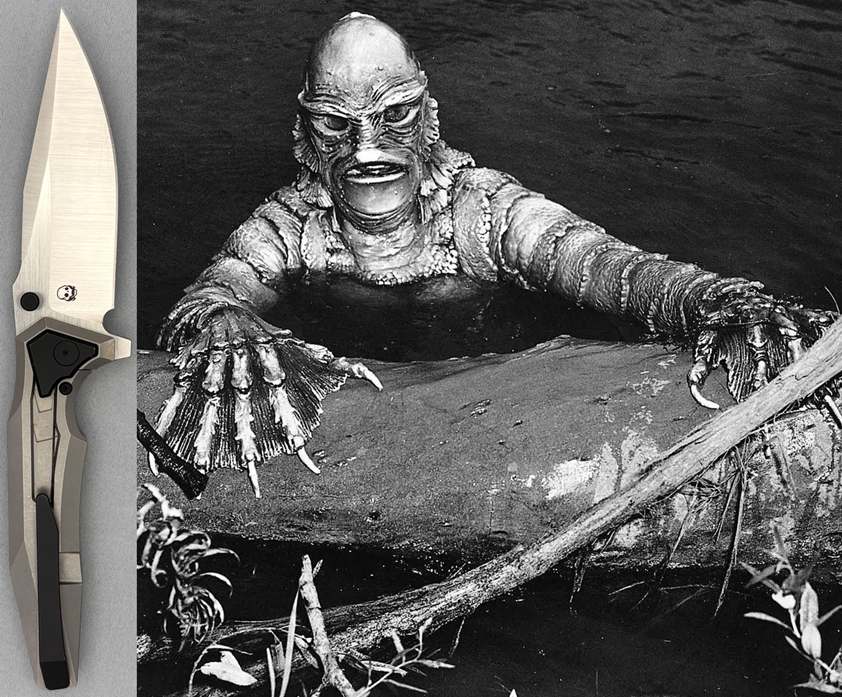
Now, if you want an example of a freaky design for a freaky creature from a freaky horror movie, you gotta see this.
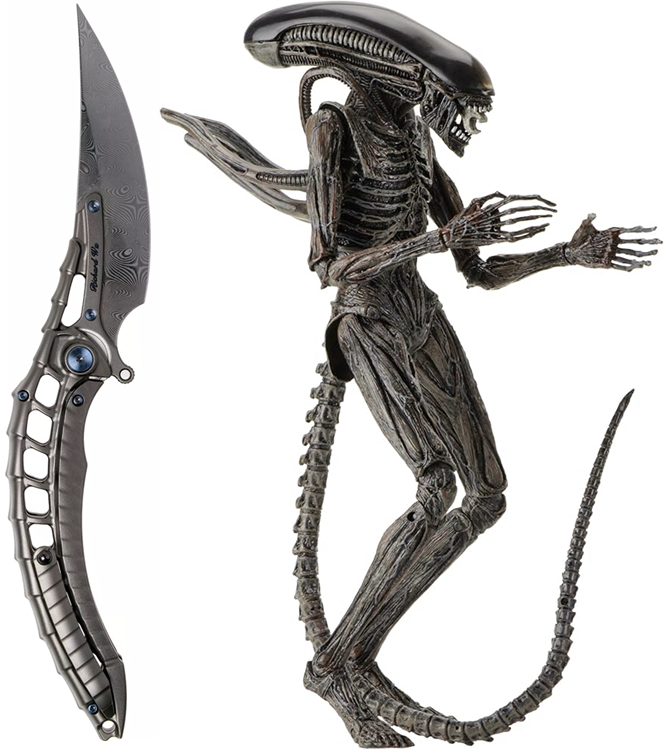
While the Rike Alien 4 knife above is a real knife you can buy, it’s creepy AF. It’s so over-the-top that it really has no place in anyone’s pocket as anything other than as a freakshow novelty. The Arcane Design Creature, on the other hand, is an actual pocketknife that is ready to be carried and do some work. It’s far more practical, even though it is still a highly stylized knife design. But as horror goes, I’m a bit creepified only by that Xenomorph handle. Yeech.
I really appreciated that when you put the Creature in your hands, it immediately shows its excellent manufacturing quality. And when you learn that Reate Knives was the OEM, it makes total sense. Reate quality is unmistakable, and the Creature has it in spades. I will include detailed, close-up photos that show what Reate can do with an excellent knife design. It’s a wondrous thing.
Arcane Design Designs
I want to take a moment to talk about the design language used in all Arcane Design knives and knife-related products, and how it shows up in the Creature. All of Israel’s designs are very much iterations of a theme. If you were to take just a glancing look at the Arcane Design knife designs, you might be tempted to think they are all very much alike. Perhaps even that they are all the same. Well, not exactly! Let’s talk about it.
Arcane Designs are mostly folding knives, but there is a fixed blade and even a cool, small pry bar / bit driver tool. There are a variety of blade shapes used, include tantos, hawkbills, clip points, Persian trailing points, drop points, wharncliffes, Bowies, even daggers, and those blades come in S90V, MagnaCut, M390, 20CV, S35VN or Damasteel.
The handle scales almost universally come in 6AI-4V titanium, but one knife is also available in aluminum, another is available in carbon fiber, and 2 models are available in G10. Some handle scales have flat inlays, others have raised overlays, some have milled out sections that look like their inlays fell out, and others are just plain. Most have accent-colored, geometrically-shaped, raised titanium overlays as a pivot collar.
The locks used are either frame locks or liner locks. The blade opening methods come in thumb studs, fullers, opening holes, and flippers. Most knives use pivots with double-sided T8 bit driver sockets, but a few don’t (this should change – no one should believe they need to have two bit drivers to disassemble a knife anymore!).
However, all of the knives use caged bearings. All of them have blades with clear, crisp grind lines separating the primary bevel from flats, swedges, compound grinds, or even each other (as with the dagger). All the handles have the form of a center flat with edge bevel cuts to the scale perimeter.
And most importantly, all these designs are very angular. I mean really angular. Like geometric angular. Like Kryten angular!

So while the knives do have a very similar design language appearance, it’s the details that separate them from one another. And given the fact that Reate (and I believe occasionally Bestech) are the OEMs for Arcane Design knives, the excellence in the manufacturing quality brings the absolute best opportunity for these creative knives to shine. The Arcane Design Creature is no exception. Let’s move into the details.
Details and Specs
There are a lot of details to cover with the Reate-made Creature, so let’s go!
Blade
The Creature uses Böhler M390 steel and comes with either a tanto or a clip point blade (the website calls it a drop point, but I know a clip point when I see one). The blade employs a saber grind, and sports a fine, vertical machine satin finish on both the primary bevel and the swedge, but offers an even finer, horizontally-oriented, brushed finish on the flat for an attractive contrast. The blade’s aforementioned 3 sections are expertly divided by clean and crisp grind border lines, which significantly contributes to the geometric angularity of the overall knife design.
Blade Details
The swedge measures ~17°, making the swedge angle off the spine at 107°, give or take a few decimals, and it starts its run at 20.4% down the spine (as measured from ~midway down the height of the blade at the ricasso) and extends down to the very point of the tip. The blade has neither a fuller nor any spine crowning, but there are 10 coarsely-spaced jimp cuts at the base of the spine that are flattened along the tops, leaving them only barely grippy.
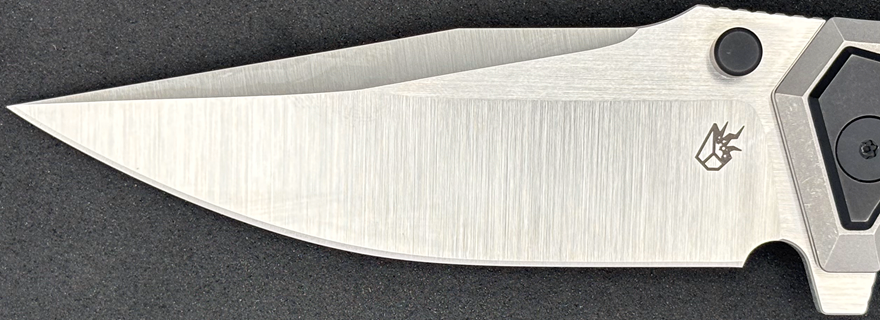
The blade edge of the Creature is very sharp out of the box, and no wonder. The edge bevel grind is perfectly executed (unlike the Benchmade Shootout I recently reviewed!), evenly ground from choil to tip on both sides, and the edge grind remains perpendicular to the primary bevel even as it rounds up the belly. Very impressive!
But you know what is also sharp on this blade? The spine edge! With all the chamfering done on the handle of this knife, no one took the time to feel the edges of the blade spine. They’re not the famous “Spyderco Spine” sharp (thanks to the swedge), but they’re in the same neighborhood, if not on the same street!
Choil
The blade edge comes equipped with a half-circle choil spanning 7.60 mm / 0.299″ – far too small to be used as a finger choil, so it serves as a sharpening choil. Unfortunately, the implementation of this sharpening choil will quickly become problematic for those who like to sharpen their knives. With the starting position placed within the ricasso, the sharpening choil is intersected by the plunge grind line at its halfway point instead of the plunge grind line intersecting at the beginning of the choil. As a result, the choil ends at the end of the plunge grind curve. So once the sharpening enthusiast begins to remove blade material, the sharpened area at the choil will run into ever-thickening blade steel in the plunge grind area. This is very disappointing.
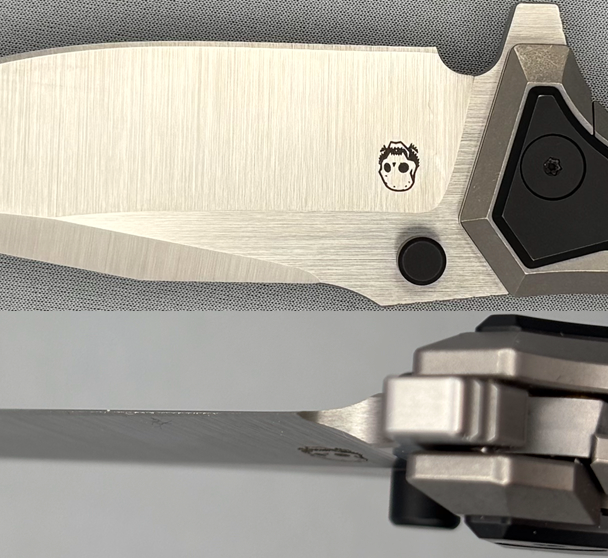
As a comparison, take a look at the Civivi Vision FG I reviewed in an earlier article. The choil resolves down to a very thin edge of the blade stock, giving the user plenty of steel to remove during sharpening over time and still maintain a great back edge instead of a “smile”. Do you see the difference?
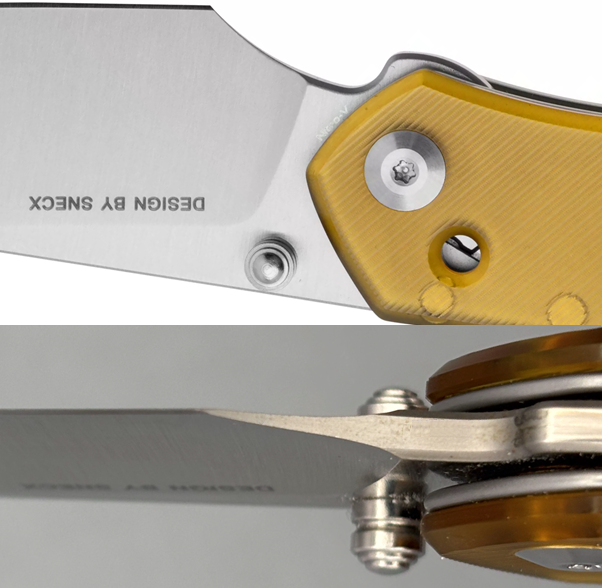
Blade Markings
The Creature’s blade markings are minimal and cleverly done. On the show side, the only visible mark on the open blade is the small Arcane Design logo, positioned high on the primary bevel next to the ricasso. Similarly, on the clip side, a skull logo that refers to The Creature line of knives (each model in the Arcane Design lineup has its own icon logo) is also positioned high on the primary bevel next to the ricasso.
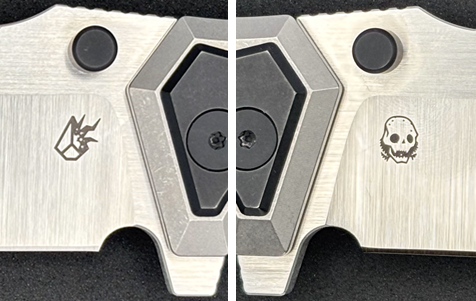
However, when the knife blade is in between being fully closed and fully opened, another set of blade markings are revealed. On the deepest part of the show side’s blade spine tab that fully and deeply shoulders the opening stop pin, the steel name 20CV is presented. A very clever move! Similarly again, on the same spot of the shouldering tab on the clip side is the serial number of the knife – in this knife, we see 054. These markings fully disappear underneath the scales when the blade is open or closed. Overall the presentation is very clean – no billboarding on the blade.

Lastly, the tip of this blade is amazing, reflecting Reate’s exquisite milling. It shows those crisp grind lines that extend all the way down to the tip, and ends into pretty much a multi-ground sharp needle.
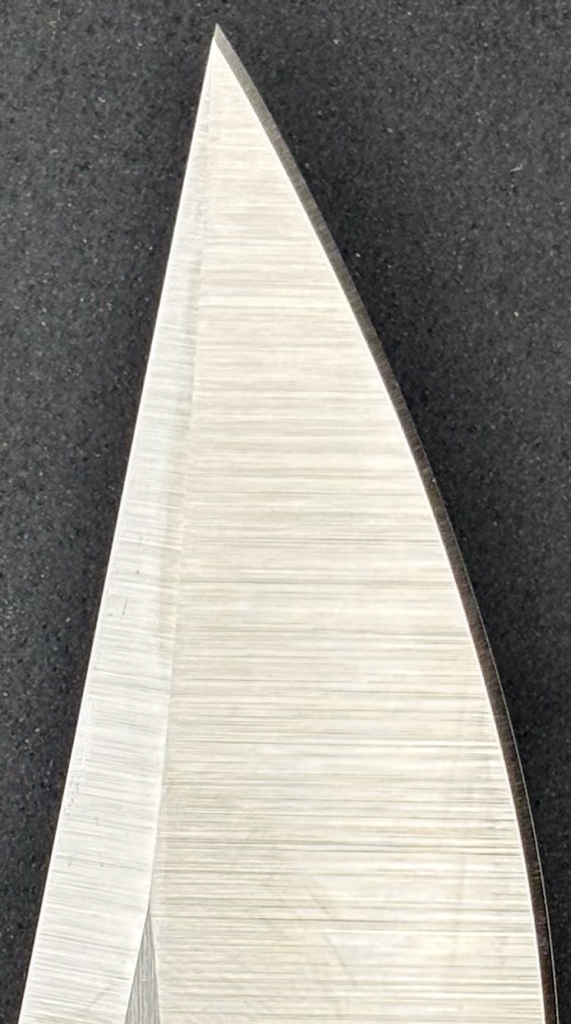
CPM 20CV TECHE
When I can get the ratings data for the knife steels I review (I primarily gather the data from the authoritative KnifeSteelNerds.com as available), I include it here in a section I call TECHE. What does that mean? Well, just look below.
Note that all but HRc Hardness Range are based on a scale from 0-10; Hardness is based on the Hardness Rockwell C scale, which technically is between 20 and 68.

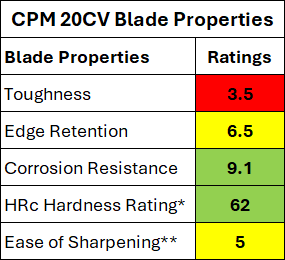
* HRc Hardness Rating data was gathered from Knife Steel Nerds.
** Ease of Sharpening data is not a rating produced on KSN.
Blade Dimensions
Let’s go over the numbers. The blade length of the Creature is 98.87 mm / 3.89″ and offers a cutting edge length of 92.45 mm / 3.64″. The blade height was measured at 32.62 mm / 1.28″, and the diameter of the thumb studs came in at 3.89 mm / 0.153″. By the way, the thumb studs span across the blade is 12.84 mm / 0.51″, which makes it slightly wider than the knife handle itself (excluding the raised pivot overlays width, to be covered below), and the main bevel edge thickness is 0.51 mm / 0.02″.
HRc Rating
Arcane Design doesn’t identify the hardness of its CPM 20CV blade, so I had to fall back upon the website of metallurgist, Dr. Larrin Thomas, Knife Steel Nerds. A little digging revealed that the typical, heat-treated hardness of CPM 20CV, Böhler M390 and Carpenter CTS-204P, all of which are basically the same steel, have a hardness rating of 61.9. Of course, the HRc rating of the blade of the Creature is affected by how effectively and thoroughly Reate heat treated their CPM 20CV steel. Since the Reate data is not known, I don’t have a working HRc testing machine (crap!), and we have no other data to go on, we’ll have to go with the KSN rating of 61.9 HRc. Hopefully the actual Creature blade HRC rating is not lower than that.
Opening Mechanisms
The Creature offers 2 methods for opening the blade.
The 1st is a set of black, flat-ended, cylindrical studs with chamfered edges, each measuring 3.89 mm / 0.153” in length. They are decently comfortable to use as there are no sharp edges, even though many users prefer studs with a dome at the end. However, given the powerful angular design language used in the Creature, these cylindrical studs are perfectly cast in their role here. The studs do intrude into the cutting path, but by just 3.75 mm / 0.148”; not bad enough to make using the knife unbearable, but enough to make it potentially annoying when cutting cardboard, assuming you, like many others, start cutting cardboard near the back of the blade to get more leverage.
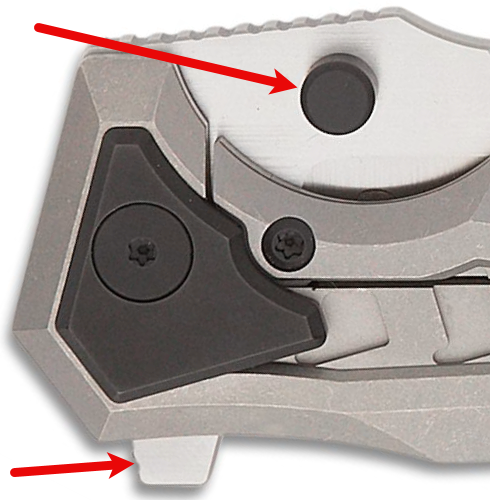
The 2nd blade opening method is a flipper tab. It’s a trapezoidal-shaped tab on the blade tang that, when the blade is closed, extends past the top line of the handle, just above the pivot. The tab is jimped on the top end (as the handle is held vertically with the pivot on top) with 2 shallow cuts that give just enough of grippy traction to make using the flipper tab a dream! This flipper tab has a deep-milled slot in the front, hidden within the handle scales, that envelopes the stop pin when the blade is closed. But wait – there’s more!
When the blade is open, that tab, located at the bottom, back end of the ricasso, starting at the back side of the sharpening choil, serves as an excellent finger guard. The design here is not only comfortable in each position with its lightly chamfered edges, it just drips with efficiency.
The flipper tab is the easier deployment method (the reason for which I’ll discuss in a moment). That tab is 100% a light switch flipper. I can’t see how it could be used as a push button unless a little bit of light switch cheat is added to the motion.
However, I both love and hate the thumb studs on this knife. What I love about using the thumb studs is that you can absolutely launch that near 4” blade into the open position with a loud, metallic, and very satisfying BAM. The flipper, at least to me, offered a bit of a softer launch, and the sound is a bit different. Using the flipper tab produces an extremely close, double pop sound due to the popping of the detent (more on that in a sec) before hitting the stop pin. But I am totally a studs gal, and there’s no double pop. It’s a pure and simple BAM! So what do I hate about the thumb studs? Read on.
Locking Mechanism
The Arcane Design Creature employs a frame lock, a blade locking mechanism invented by Chris Reeve in 1991 and introduced on his lauded CRK Sebenza folding knife. The frame lock design is 34 years old now. Yes, it works, as long as the blade tang and the frame’s lock bar faces are correctly milled; it’s a sturdy and reliable locking system. Assuming the milling is done correctly, and sometimes it’s not. Luckily, the Creature has perfect milling (nice work, Reate!) and the lock is very secure.
However, and this is BIG, the rather wide frame lock bar on the Creature’s handle can make opening a knife needlessly difficult. The knife user must intentionally focus on not putting their fingers onto the frame lock bar when attempting to open the knife. If this happens, the lock bar will press onto the blade itself, significantly adding friction resistance to opening the knife, often enough so to prevent the knife from opening. This issue is even more difficult to overcome when the knife handle is narrow, providing even less room for fingers to press and hold the knife handle into the palm without also pressing on the lock bar.
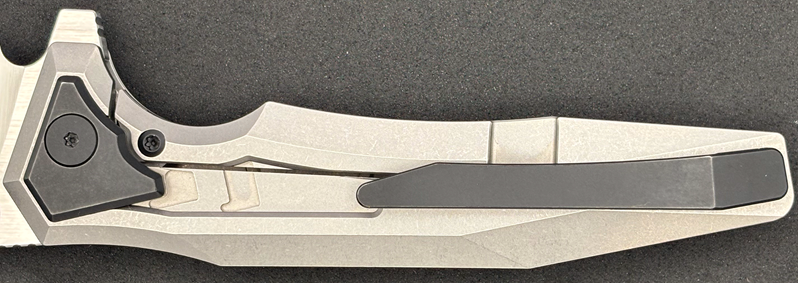
This is my key gripe with the very short height handle of the Creature. Its open handle height (where I put my fingers) is 24.07 mm / 0.948”. The lock bar is 9.92 mm / 0.391” in height, which makes it 41.2% of the whole handle height. More importantly, any handle space beneath the pocket clip really isn’t useable space for holding the narrow handle in the opening action. A taller handle would give the hand more room to grasp the handle and more easily press it into the palm for support.
But in the case of the Creature, unless you have Deadpool baby hands, your fingers must sit on the topside of the low-placed pocket clip. And you’ll likely need to exclude using your index finger altogether to hold the pocket clip, or you’ll still press into the lock bar.

I can open the Creature by carefully positioning my fingers on the top edge of the clip but not touching the frame lock bar, and then using the thumb studs to open the knife. But it’s not fast or automatic, at least not initially – it takes specific hand/finger positioning to make this work, and that takes time to learn. Perhaps I need more practice, maybe another 2-3 thousand opening experiences, to get this down (ha!). The flipper works perfectly because the frame lock bar is not actively engaged with that method. However, the flipper doesn’t really give you that powerful, satisfying BAM-into-place opening that a strong thumb stud flick does.
I don’t know if the Creature’s locking system was designed as some sort of performance litmus test, an exclusive, advanced-user-only, feature, or maybe Israel is so familiar with the frame lock design that he doesn’t recognize the difficulty others might have in using this opening method on his knife. For all I know, he might just advocate for using the flipper as the primary opening method. Who knows. And in profound irony, this futuristically-designed knife uses a very old blade lock system. I don’t get it.
I’m definitely not a fan of this lock on this knife.
Knife Lock Considerations
There are so many ways that the difficulty of using a frame lock on a narrow handle can be negated these days. So let’s take a moment to explore the frame lock mechanism and possible locking alternatives that would make the Creature a more user-friendly knife to use.
Frame Lock
This is what the Creature uses now. So how does a frame lock work? It uses part of the handle’s frame to act as a leaf spring that is set to bend inward. When the blade is deployed, the frame lock leaf spring pops inward into place behind the blade tang. That section of the blade tang is ground to a specific, shallow angle so that the front of the frame’s leaf spring, typically a titanium lock bar with a steel insert attached to the tip, engages the milled angle on the blade tang with steel-to-steel contact, preventing the blade from closing.

To release the frame lock, the user pushes the frame’s leaf spring lock bar back away from the tang, allowing the unlocked blade to return to the blade channel in the handle. A relief cut in the frame lock bar allows the leaf spring to flex more easily, making it easy to use. The relief cut may be external or internal facing
The frame lock is sturdy, as long as there is good contact between the leaf spring steel insert and the milled tang. This means that the lock bar slides deep enough onto the tang (so the lock bar contact doesn’t slip off under pressure), and that the tang’s milled angle allows the lock bar to stay in place (too steep an angle would not hold the lock bar in place, and too shallow would not allow the lock bar to be easily released). This isn’t always the case, but as you can see below, the Reate-made Creature has solid lock up.

It’s noteworthy to recognize that to release a frame lock blade, you need to put your thumb across the blade’s closing travel path. This means that the blade could fall onto your unprotected hitchhike pollex. Well-designed knives have some level of semi-protective features, such as an extended tab on the blade that falls first into your thumb nail, giving you a moment to safely withdraw your thumb from the blade travel path. Higher-end knives often have very smooth, slower actions where the pivot design helps slow the blade fall with a gentle, buttery slip into place rather than a freefall like a guillotine on greased bearings.
The biggest trouble, though, with the frame lock is the likelihood of pressing onto the full-length, fully exposed frame lock bar, which can make it very difficult, if not impossible, to open the blade. This is a common and very frustrating experience, especially among knife users who just acquired their first frame lock knife.
To mitigate the potential troubles of the frame lock’s lock bar, several alternative blade locks exist that would not have any significant (if any) effect on the Creature’s existing design aesthetics.
Nested Frame Lock
The nested frame lock is almost exactly like the regular frame lock. It uses the same style leaf spring lock bar on the frame. It engages the same way, and it releases the same way. The only difference here is that the frame lock bar is mostly hidden behind the clip side scale (typically made from G10, micarta, Ultem, or carbon fiber), with only the smallest profile of the lock bar exposed. The benefit of this, of course, is that the incidence of erroneous presses on the lock bar when attempting to open the blade are significantly reduced, if not eliminated. Otherwise the lock is just as strong as the regular frame lock (with the same caveat that as long as the blade tang lock up is deep enough and correctly angled to hold the lock bar’s steel insert in place).
A good example of a nested frame lock is the Civivi Savant, as shown here:

Bolster Lock
The bolster lock, another variant of the frame lock, pushes the minimization of the exposed frame lock bar even further, only presenting a small tab to release the frame lock bar within a cutout in the scale/bolster on the clip side. This means the entire lock bar is covered, eliminating the pressed frame lock bar from being an obstacle to opening the knife. In the example below, the lock bar release tab is positioned in a bolster designed into the handle design. It’s still a frame lock with all the strength of the earlier frame lock variants (with the same caveats on the lock bar depth on the tang and the proper milling on the blade tang) but offers a much better user experience.
A great example of this lock in use is the titanium-framed bolster lock on the Varga Knives VBR MkIV, a beautiful and sexy knife. That said, the steel insert to blade tang lockup doesn’t look very secure, does it?
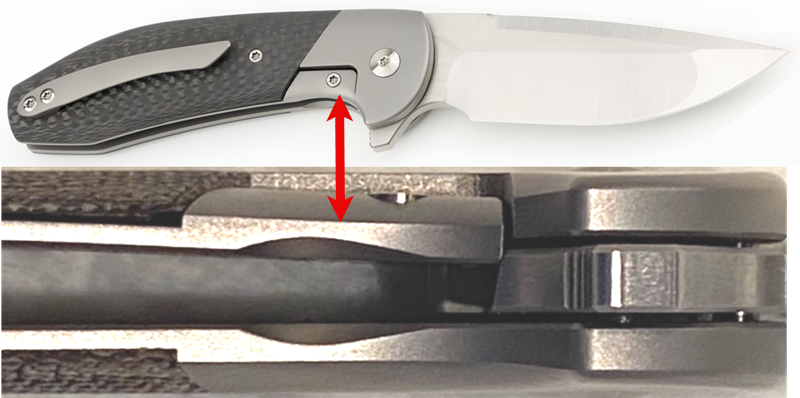
Liner Lock
An even older variant of the frame lock-type system is the liner lock. The leaf spring lock bar is not part of the frame, but is a lock bar spring attached to the liner. Otherwise, the function of the liner lock is the same as the frame lock. The lock bar still springs onto the milled blade tang when the knife is opened, and the same press on the liner lock bar off of the tang releases the lock.
Some challenges of the liner lock are that the liner leaf spring are often very thin, which can mean the blade tang interface with a thin strip of steel may slip off the tang more easily than the thicker frame lock contact points. This liability is typically found on low-end budget knives, where investing in building up the liner bar lock up interface is neglected, but that is a design decision, not an inherent design flaw.
A good example of a liner lock is the Harbor Freight Icon folding knife, which I reviewed earlier this year.
Honestly, any of these alternative locking systems would be better than the existing frame lock on the Creature. I am especially a fan of the bolster lock style, in which only a small tab is exposed for releasing the lock, but the frame lock bar is neatly tucked away behind the scale. Hey, Israel, my friend, what do you think? I’d bet that Reate would knock your socks off with a nested or bolster style frame lock.
Of course, my friend, you might also consider going in a much more modern direction with your futuristic-themed knives. The recently patent-expired compression/top liner lock could be very interesting. Vosteed is eating everyone’s lunch with this excellent lock. There’s also the patent-free Superlock designed by Snecx Tan (here’s another reason to check my review of the Civivi Vision FG!). And, of course, the patent for the Benchmade Axis lock also (relatively) recently expired and crossbar locks have become very popular (although I’m not really a fan of omega springs). But given the creativity between yourself and the folks at Reate, perhaps you can design your own lock! I wrote about how Bryan Winters of Winterblade designs a new locking mechanism for every knife he designs (the guy is a creative and engineering genius!). The old and ill-fitting frame lock is the only sub-par feature on your Creature knife. I believe you can do better.
Detent
The detent action on the Creature is truly a beautiful thing. The rounded (not squared off), smooth detent ball is located on the frame lock bar very close to the top front edge. This means the blade will very quickly engage the detent when the frame lock bar releases the blade, preventing double-clutch, which feels like the need for a double-disengagement of the blade as it begins to fall but sticks on the mispositioned detent ball and stops closing.
If you want to see what a terrible case of double-clutch feels like, visit your local Harbor Freight and drop $10 to buy their Gordon Drop Point Pocket Knife 57584 GK24, which I reviewed earlier this year. When you push the frame lock bar release away from the blade tang lock up, there isn’t any hint of double-clutch with the Creature. Below is an image of the blade tang resting against the detent ball. If the blade (offscreen to the right) is about to close, the tang will push the detent ball back (up in this image), allowing the blade to close. At the end of the closing, there is a small pit on the blade into which the detent ball falls, where the pressure of the frame lock bar’s leaf spring holds the blade closed.

When opening the knife, the detent ball on the frame lock bar leaf spring rides along the tang until it slides off and the lock bar steel insert makes direct contact with the last bit of the tang. As the momentum of the blade carries on, the tang rolls up to the angled flat spot, where the lock bar springs into place. Note in the image below how perfectly the Creature lock bar steel insert engages with the tang. This is Reate work – very high-quality milling. Also, note the arrow in the image. This is the back of the clip-side, geometrically-shaped, raised titanium overlay pivot collar. That notch serves as the frame lock bar over-travel stop, which prevents the user from pushing the lock bar further than necessary, protecting the knife’s structure. Very nice!
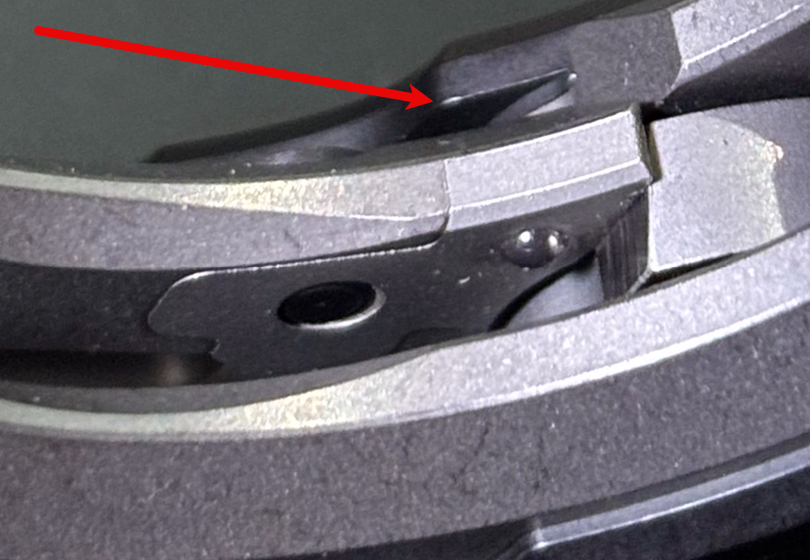
Lastly, the image below shows the detent ball on the blade tang when the blade is half open. I would have included a photo when the detent ball is in the closed position pit in the blade, but the detent ball on the frame lock bar drops so low as I can’t get an image with the crappy photo setup I am using!
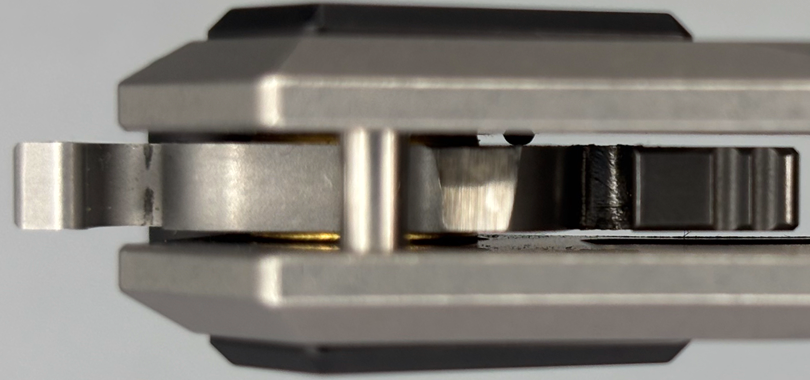
Suffice it to say that the detent on the Creature is an excellently executed feature and contributes to the satisfying blade lockup system and the action being super smooth, even though it’s not user friendly when opening the knife.
I can attest to you, my dear reader, that the Creature has no blade play, no lock stick, no lock rock, no pivot lash, and no detent lash. This is a very well-made knife.
Knife Body & Scales
The Creature, like most of the Arcane Design knives, uses US grade 5 titanium alloy, also known as 6AI-4V (there is a common typo in pocketknife nomenclature that calls Ti grade 5 6AL4V, but that is not correct. The name comes from the elemental composition of this alloy, being 6% aluminum (chemical element AI, not AL), 4% vanadium (V), with the remainder as titanium (Ti). Now you know. You’re welcome). The Ti scales on this knife wear a stonewashed gray finish.
Scales
The key to the Creature design is the special milling done with the stonewashed handle scales. It starts with the handle’s 10 distinguishing, geometric-styled, edge slice regions that meet with distinct border grind lines, creating a strong, sculpted look. At the pivot is placed a 7-sided, geometrically-shaped, raised titanium overlay that serves as a pivot collar overlay. Note that both the scale and the raised pivot overlay make use of a combination of straight, slightly curved, and rounded edge lines of various very short to quite long lengths, a pattern that establishes the Creature’s design. The black accent coloring of the raised Ti pivot overlay is likely due to a dark coating like PVD which was then stonewashed. I can’t be certain, though, as it’s not specified on the Arcane Design’s Creature webpage.
The scales are quite smooth except for the center section, where there is a milled section that looks like where an inlay would go, but the inlay has fallen off! But this is not the case – it was designed to have this look. Furthermore, the milled section has its own, deeper, milled pockets. Those elements add visual interest to be sure. However, the edges of those deeper milled pockets are sharp, 90° edges. Luckily, they are small, but you do feel them on the pad of your thumb. As Borat would say, “Not Nice!”
The handle’s cutouts provide easy access to release the frame lock bar. The cutout on the clip side is the same size as the show side, and the lock bar does travel inward a fair bit, so there’s not a lot of room for releasing the lock. However, the edges are all nicely finished with no sharp edges. A little press into the slot with your thumb gets you all the lock bar access you need.
The handle doesn’t use liners for structural support; the beefy titanium scales do double-duty and provide this function as well.

One much appreciated feature is that the scales are milled for weight reduction – on both sides!
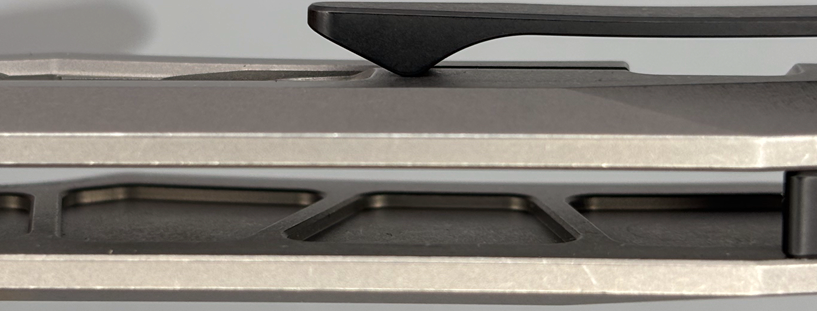
Pivot Washers
The pivot employs phosphor-bronze washers, which deliver buttery smooth blade action. It’s wonderful!

Oddly, the pivot is designed to appear as free-spinning, which would require two T8 bits and drivers to disassemble the knife. However, only the clip side pivot face turns. Truth be told, I didn’t try too hard to turn the show side pivot as I didn’t want to strip the pivot socket, and I didn’t disassemble the knife as it is on loan to me. So from this limited amount of data, I can only conclude that Israel designed the pivot faces of the Creature to be symmetrical. This unfortunately also means the Creature pivots resemble those on a crappy, cheap knife. Yes, that feature could be considered “designy”, but this one, assuming my hypothesis is correct, is a very odd choice.
I’m no knife designer, but this seems akin to adding the skinny, steel wheels with hubcaps and the chrome bumper of a 1960s VW Beetle on a onto a new Corvette ZR1. It just doesn’t work, not even as an absurdity. It’s more of an abomination.
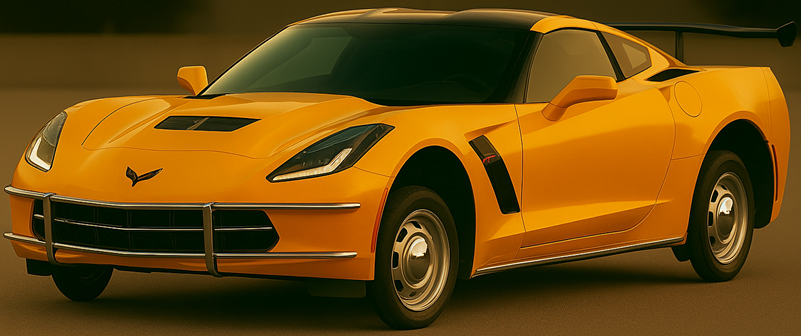
Stop Pin
The fastener-free stop pin, whose diameter measures 2.90 mm / 0.140”, is located in the usual location on the top front of the handle (any mounting screws would be located underneath the raised pivot overlay), exactly above and aligned with the pivot. The blade tang has 2 contact points for the stop pin, and both offer significant shouldering to ensure the blade always stays in place. And because of the blade design, the stop pin doesn’t come anywhere near contacting the blade at the sharpening choil (some knife blades do, and after much usage and many sharpenings, any such contact can damage the heel edge bevel of the blade).
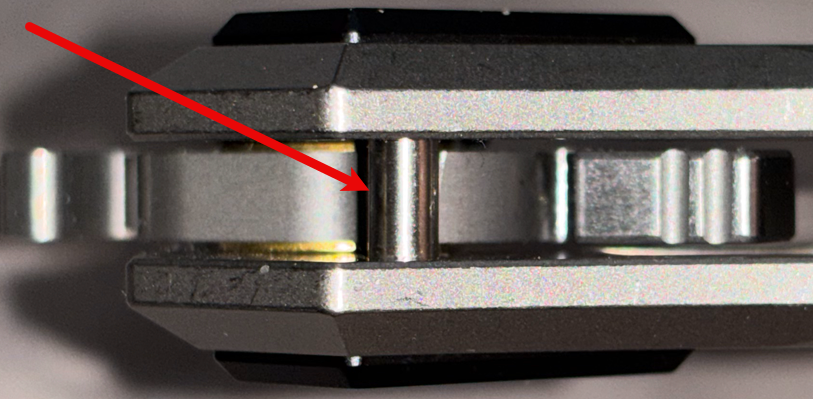


Backspacer
The Creature has an inky dinky do backspacer made of 6AI4V titanium alloy, like pretty much everything else on the Creature handle. It is presented in the same black accent color and hosts the same stonewash finish as the raised pivot overlays.

One cute little addition to the backspacer is the branding label of the knife. Keeping such information off the blade markings is emotionally difficult for some designers, as they worry that newish customers to the knife world, or even seasoned veterans who might be unaware of their brand, will not know how to identify, and then find again, their beautiful knives. Arcane Designs solved this little conundrum by making the brand very visible—inside the blade channel at the butt end of the handle.
And did you notice how the blade is straight-on centered? This is after an excessive number of strong-thumbed openings, and the blade remained perfectly centered. I love it!

Lastly, to the deep chagrin and loud lament of the last 3 dudes who care about lanyards, Jordan, Kent, and Owen, the Creature has forsaken you! There’s no lanyard mount on this knife whatsoever. Don’t cry, boys; people are watching.
Handle Dimensions
Let’s run the numbers. The handle length runs 120.05 mm / 4.73”, the closed handle height was measured to be 32.01 mm / 1.261”, and the handle thickness came in at 12.71 mm / 0.501”. The thickness of the titanium scales is 3.98 mm / 0.157”. The measurements above determined the blade-to-handle ratio to be 0.82. The amount of open frame lock bar lockup on the tang was measured at 44%.
Let’s also cover some more esoteric measurements. They may not be interesting to you, but I find them fascinating, and since I’m the one writing this review, my rules win! The distance between the pivot center and the thumb stud, where higher numbers can mean less leverage for easy, fast opening, is 19.59 mm / 0.772”. The thumb stud angle from the vertical center of the closed knife is 41°. The amount of space between the thumb stud and the scale edge is a very generous 5.51 mm / 0.217”. The amount of thumb stud presented into the blade’s cutting path was approximately ~4 mm / 0.158” – not bad at all. The balance point of the open knife away from the center of the pivot was 14.84 mm / 0.584” down the handle, meaning the knife is a bit of a big booty mama. The angle of the flipper tab from the pivot at the knife’s vertical center was 96°.
Lastly, the length of that inky dinky do backspacer came in at a mere 39.30 mm / 1.55”.
Hardware
The Creature comes with a milled titanium, medium carry, pocket clip. Once again, it uses the same accessory, stonewashed accent-colored finish as everything else not being the blade or the titanium scales, which is a continuation of Israel’s design. The length of the pocket clip is 64.51 mm / 2.54″, which makes the clip length to handle length come out to 53.7%, a measurement that makes it a slightly oversized clip. I like the way the clip has a diagonal, almost a geometric angle (!) cut at the end, but still ends with a comfortable, circular tip.
The clip has no visible mounting fasteners. It’s a small detail that has a large influence on how sleek and smooth the knife looks. On the underside, the clip touches the smooth handle scale with an angular, V-shaped ramp toe. The clip is tip-up, right-handed only (sorry to all our Sinister, Southpaw, Cuddy Wifter, Goofy-Footed, Mollydooker, Katy-handed friends).
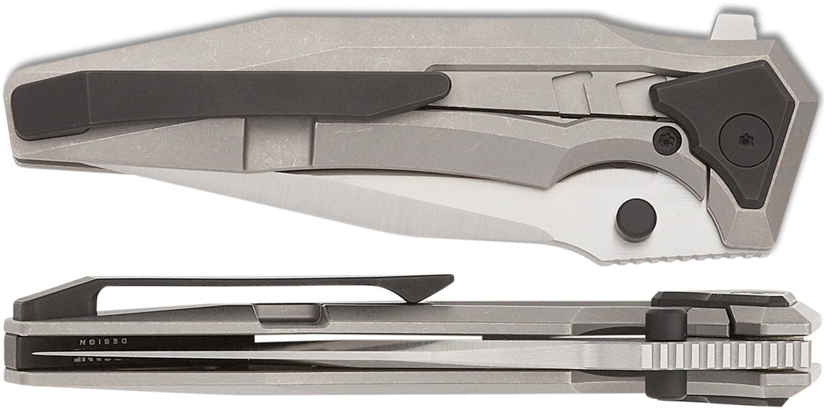
Unfortunately, the pocket clip is as stiff as a Calvin Coolidge press conference. That’s really stiff, since ole Silent Cal has been dead for 93 years (and silent for decades more). I had significant troubles getting the pocket clip onto my pocket. This aspect of the Creature was a disappointment for me.
As for fasteners, the Creature is consistent in using only T8 fasteners – everywhere! Not only the body screws (on the show side!), but also on the frame lock steel insert screw and on both sides of the pivot! Yeah, cool and weird. As for that show side issue, I can understand that the placement of that fastener-less pocket clip makes it harder to have the body screws only on the clip side. But that said, the end show side fastener must be for securing both the end of the knife as well as the pocket clip. But that leaves the second screw, which must be for the backspacer. The clip side room right there is really close the pocket clip. I wish that Reate could have moved the fastening point for the backspacer further up the handle, which would have allowed for it to be a clip side screw, leaving only 2 show side screws (including the likely fake pivot face screw).
I can compliment Arcane Design for the fact that all the fasteners, like all the other accessory parts, are matte black coated. That’s very nice.
Ergonomics
Despite this being such a physically angular-handled knife, the ergonomic grip is really comfortable in hand. The finger cutout area behind the guard is the same area that the thumb uses to release the frame lock. This area offers a generous cutout for the thumb stud, and that area has a very nice, rounded, angled cut, making that edge a joy to hold. The inner edges of the scales are just slightly chamfered, which contributes tremendously to the comfort in the hand. The little ramp on the blade spine that leads up to the high point, just past the thumb studs, is mildly jimped, but it also contributes to the comfort of the grip.
Israel of Arcane Design has developed a design formula maxim that states the narrowest area behind the fingerguard must be 19 mm / 0.75” in height to achieve the most comfort in hand. I believe he’s found the Golden Triangle secret for pocketknife handle design, and it works!
But a big part of the ergonomic review must include the ease of opening, specifically when using the thumb studs. I covered this above when I wrote about the frame lock problems, where I discussed the difficulty of opening the knife with the thumb studs without pressing on the lock bar. The narrowness of the handle’s back end almost necessitates the user to contort their fingers and hand to open the knife, and I believe this is the biggest problem with the Creature. It isn’t a deal-breaker, at least not for me, as I have it figured out, but it is a needless difficulty in such an otherwise beautifully designed knife.

Weight
The Creature is a chonky little monster. It’s not Godzilla, but it’s not Casper the Friendly Ghost, either. This scary creature, wielding its 3.89 mm / 0.153″ thick blade and its pair of 3.98 mm / 0.157″ thick titanium scales, weighs in at 130.93 g / 4.62 oz. That, and the blade length measurement of 98.87 mm / 3.89″, gives the Creature a weight-to-blade-length ratio of 1.32
Original Packaging
Arcane Design didn’t stop the design work once the knife was done. I was impressed with the cool packaging sent with the knife. Let me show you what I found.
It starts with a heavy, rigid, paperboard tray with sleeve box. The black sleeve, opened on the long end, has a transparent window to see the contents of the inner red tray.

As an aside, on the side of the black sleeve is what appears to be the company slogan: Modern Design for an Ancient Tool.

The box tray has a pull tab ribbon with which you extract it from the box sleeve.
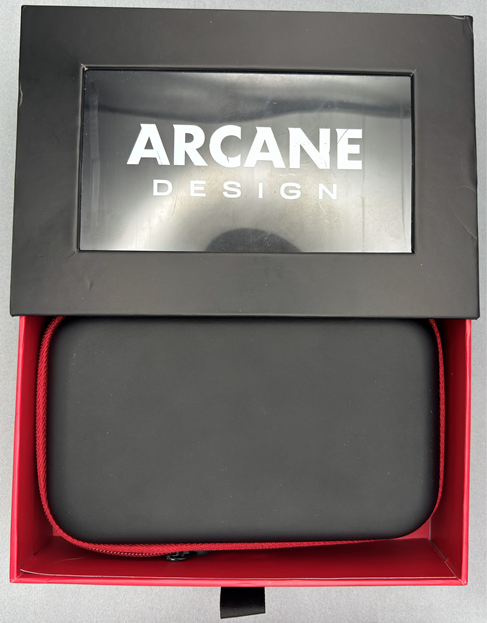
Once the tray is slid open, you discover that the black background for the sleeve’s window was a large, spacious, zippered, hard-sided knife case. When you remove the knife case from the tray, you discover a quick message of gratitude from Israel, the founder of Arcane Design.

The opposite side of that knife case previously cradled in the tray is a large, rubberized patch of the Arcane Design company logo attached to the case.

You’ll undo the perimeter zipper to see a foam-lined box containing a Certificate of Authenticity card hand-written by (presumably) Israel himself. There may have been more box content, but as this knife was loaned to me, this is all I received.

The Certificate of Authenticity identifies the feature details of the knife model in the box, including the blade steel, blade and handle finishes, blade shape, and the serial number for these limited release runs.
Hey, Israel, you’re a cool dude and all, but might I suggest you work on your penmanship?
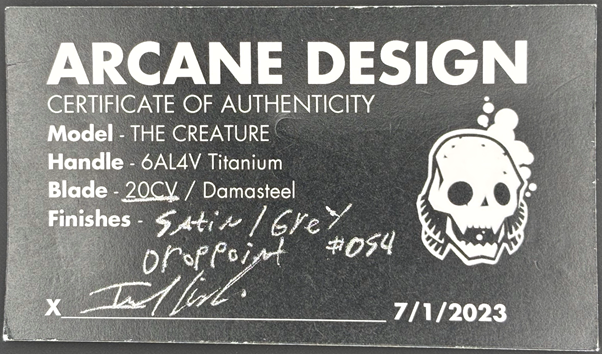
Knife Karen Nitpicks
The Arcane Design Creature is a beautifully-designed knife. It’s almost a perfect knife! Well, perfect might be an overstatement. Yeah, no knife is perfect. Hmm, there were a few issues I had with the knife, so it definitely wasn’t perfect. And those issues were pretty annoying, now that I think about it. Hmm. I think I need to speak with the manager!
- This isn’t your grandma’s Barlow / Imperial / Buck knife (wait – your granny didn’t keep an EDC folding knife in her handbag? No? Seriously? I think she hid it from you). The design of the Creature (or any of the other Arcane Design knives) isn’t for everyone. The knives have a very specific, consistent, clear, and LOUD design language. It consists of geometric, angular shapes, cuts, and overlays that are very intentionally done. But I just don’t see any semblance to Lost in Space, The Twilight Zone, Star Trek, or really, even the Creature from the Black Lagoon (aside from the clip side blade marking). Dude, whattaya smokin’? And don’t bogart it, pass it along!
- Why was such a sculpted, narrow handle fitted with an old frame lock when so many other, more modern locks that basically work the same way but don’t have the liability of interfering with a user’s ability to open the knife? Seriously, this lock design is nearly 35 years old and has been redesigned in several iterative improvements. And that doesn’t include the huge number of even more modern locks that don’t rely on moving a leaf spring bar onto and off of the blade tang. Hey, Arcane Design – for a company who strives to design knives with a futuristic look, the use of such an old, needlessly difficult to operate, frame lock is a surprising anachronism.
- The handle has so many knocked down edges to make it comfortable to hold, but someone forgot to remove the sharp edges of the blade spine! Was that not on the final checklist? This was clearly an oversight. Being angular is not the same as being sharp!
- The position of the sharpening choil was a mistake. The plunge grind line hits the dead center of the sharpening choil. This mistake means that the sharpening choil is nearly useless. Once the sharpening steel removal begins in earnest, the thickness of the blade edge’s heel widens very quickly, which will make the back of the blade very difficult to sharpen at the same angle as the rest of the blade. The choil should have begun at the plunge grind line, not before.
- The nice, fastener-less, milled titanium pocket clip won’t clip! It’s way too stiff. I can’t get it to clip onto my pants pocket! It’s stiffer than Stiffy McStiffles after he got a GIF of his extra stiff rebar spinal implant from a miffed Dr. Biff Stiffy.
- What happened to the handle center inlays? They fell out! Oh, wait! There never were any inlays in the apparent milled inlay spaces? Really? This is weird. It’s like drilling extra fastener holes that don’t have fasteners in them (and not like the ambi pocket clip type holes, but rando, empty screw holes in the center of the handle for… whatever.). And there are secondary, milled inlay pockets inside the primary, center-handle inlay spaces. I find this very confusing! Could this “Where are my inlays?” thing be part of the “mystery” theme. That’s my only guess.
- The pivot faces have T8 sockets on both the clip side and the show side! I’m not supposed to disassemble this borrowed knife, but I can report that the clip side pivot turns pretty easily, while the show side seems to be unmovable, which could mean there’s some blue threadlocker there, or perhaps the pivot is actually captive, but the show side pivot face includes a false T8 socket. This would be done because… well,… what the heck is this? Why emulate the look of a low-end crap knife on a premium $350+ CPM 20CV and 6AI4V titanium knife? Is that some sort of a reverse flex? If so, it’s like buying an ultra-expensive, succulent A5 Wagyu steak and then serving it to your friends after cooking it well-done. This is just absurd.
Price
The Arcane Design is not a budget knife, unless you are, well, rich or something. For the rest of us plebeians, this knife will be a significant expense. On the Arcane Design website, the MSRP for the Creature lists it as starting at $355 (unless you want to toss off the CPM 20CV and instead go with Damasteel, which’ll hoover $625 out of your wallet). I couldn’t find many 3rd party knife sites that sold the Creature as new (the few that did were sold out). The few listings I found were mostly used knives reseller sites, where the value ranged from $210 to $380 (and none of those were Damasteel).
Verdict
The Arcane Design Creature folding pocketknife is an impressive pocketknife. I’m not gonna lie; I wasn’t so sure I’d even like it when it was offered to me to borrow for a review. When I got it and opened it, the size was impressive (it’s a 3.75” blade), but the design was just weird. But as I do before I begin my reviews, I hold it. I open and close the blade. I do a LOT of close-up examinations of the blade and handle under a magnifying glass; I look at the milling, the blade finish, the overall design and all the detailed bits that contribute to (and conflict with) that. It was that deep inspection when the quality of this knife really grew on me.
Now if you’ve been following my blog at all, you’ll know that I like the curvy, sexy stuff, and my favorite knife, for which I wrote my inaugural article, was the Viper Moon in sculpted green Fatcarbon scales and a gorgeously curvaceous modified sheepsfoot MagnaCut blade. The crowned spine, the almost organic shape of the blade, and the beefy-cake heft were right up my alley!
But somehow the perfectly executed, angular, geometric-themed Creature grew on me (it might have been related to my immediate previous review, the truly disappointing quality control of the Benchmade Shootout). The excellent build work done by Reate to bring the design vision of Israel Bacchus, the young, creatively clever founder of Arcane Design, all came together to really impress me.
The inspirational motivation for Israel is his life-long (it’s funny for me to say life-long for such a young guy!) interest in the macabre, classic horror, science fiction, outer space adventures, futurism, and mystery. His design language for all his works is distinct and very clear: he uses geometric themes, shapes, angles – it’s like going to geometry class dedicated to knives! I’m not sure I see the mysterious horror of outer space monsters here, but what I do see, I like very much.
It starts with the blade. The blade work here is really pleasing. The very fine vertical grind lines on both the swedge and the primary bevel, contrasted by the very fine horizontal lines on the flat, border one another with incredibly clear and crisp edge border lines. It’s beautifully done (contrast this with the surprisingly coarse blade finish on the TuyaKnife Anzu, of which I was no fan). The Creature’s edge bevel was ground evenly across the entire length of the blade, symmetrical on both sides, and was always perpendicular to the end of the primary bevel, culminating in the swedge and the edge bevel meeting at a needle-fine tip. Excellent! Visible blade markings are kept to the barest minimum with only 2 icons, 1 on each side: the show side is the Arcane Design logo, and the clip side is the logo for the Creature (each knife model gets its own logo). Markings for the blade steel and the serial number, hidden away under the scales when closed and open, are only revealed when the blade is partially open.
The handle carries the bulk of the design theme expression. Each side has 10 side angle cuts of varying angles, curves and lengths along the perimeter to add both visual flare as well as hand-grip comfort. The curved cutouts for accessing the thumb studs are as generous as I have seen in quite a long time. All of what might appear to possibly be straight, 90° edges are all chamfered, even most of the odd cutout in the center of the handle. The pivot collar overlay is as unconventional as it gets, being made of a raised, geometrically-shaped (triangle-ish), titanium plate, whose 7 perimeter angles, curves and lengths echo the theme of the handle scales. The milled titanium pocket clip has its own sculpted geometric accents, and best of all, it has no visible fasteners for a very clean look. In fact, all the knife accessories (thumb studs, pivot faces, pivot plates, pocket clip, even the fasteners share the same accent finish and color. It’s consistent and well done.
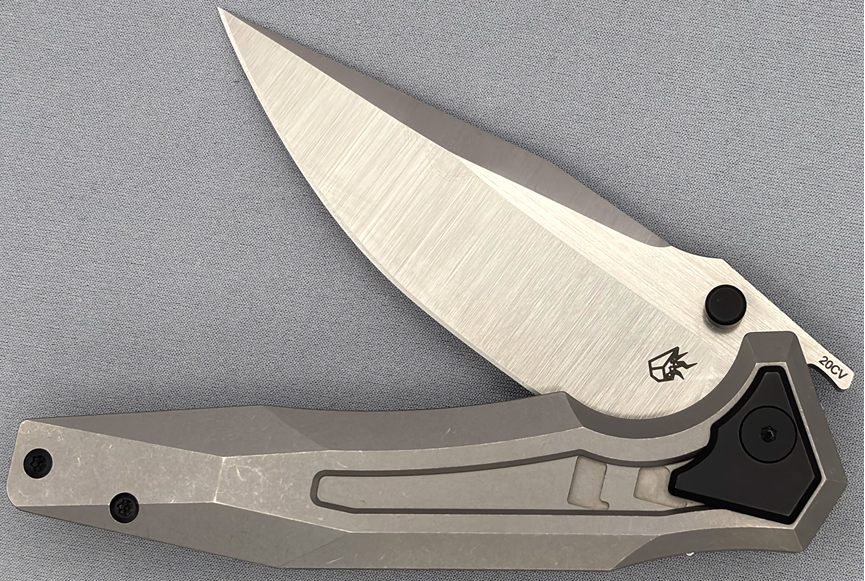
But there are some oddities and a complaint or three. The handle’s milled inlay pockets are not for inlays. There are no inlays, and the inlay-within-the-inlay pockets actually has sharp, 90° edges against which the skin padding of your thumb and index finger will be scraped clean. This is great if you are a safecracker or something, but for the rest of us non-organized crime figures, this is an irritation. And let’s talk about unfinished, sharp edges. And compared the beautiful & ergonomic edge finishes of the handle, the edges of the blade spine are completely unfinished, leaving them quite sharp and abrasive. This has to be some sort of oversight. And as long we are talking about the blade, the sharpening choil is mispositioned, at least in terms of being able sharpen the blade over time. The choil is intersected by the plunge grind, making the heel edge grow thick very quickly as material is removed. The choil should start at the end of the plunge to avoid this problem.
Getting back to the handle, the pivot faces both have T8 sockets in them! Yep, a $350+ premium knife has a show side pivot with a Torx socket in it. Now I believe this is not a free-spinning pivot. The clip side pivot turns easily with my bit driver, but the show side pivot is so immovable that it must either be using red threadlocker (if not superglue or epoxy), was welded into place, or perhaps is a captive, D-hole pivot from the show side, despite the visual design indicating what appears to be a free-spin pivot. If we hear later it was done for the sake of balance and symmetry, then there should be a pocket clip on both sides as well. And speaking of that pocket clip, it’s as stiff as a rebar-strung guitar. The clip won’t clip.
Lastly, I really object to the use of an old-style frame lock onto a handle that is so narrow at the end. There is very little room to hold the handle of the Creature in place to use the thumb stud openers without accidentally pressing on the frame lock bar, thereby locking the blade into place. The use of a nested frame lock, a frame bolster lock, or heck, even a liner lock, would be better than the current frame lock implementation. And given the futurism that Israel is pursuing in his designs, a 34-year-old locking system is a serious anachronism. Instead, add a compression-style top-liner lock, a Superlock, or design a new lock, but the frame lock is a disappointment, especially in this implementation.
Now all that aside, in the big picture view, the Arcane Design Creature is a brilliant knife. I’ve had a bit of sarcastic fun here, although the core of the constructive criticism is totally valid. No knife is perfect (I’m still waiting for Herman Knives to get back to me to prove me wrong, however), but the Creature is an excellently built knife (Reate work!) with a very clear and very LOUD design language. If that language does not appeal to you, that’s fine. It’s not meant to be an every-person knife. This is why there are limited runs on these Arcane Design knives. They are rather exclusive and clearly targeted to an audience who connects with these designs and buys them for their collections. They also sell out, so Arcane Design is clearly doing something right. Now after having handled this Arcane Design knife myself, I am a fan and look forward to my next opportunity to see, handle, examine, and enjoy another of Israel Bacchus’ very clever and beautiful designs.
To me, the biggest mystery is why more people don’t know about Arcane Design knives. Enjoy! ![]()

